
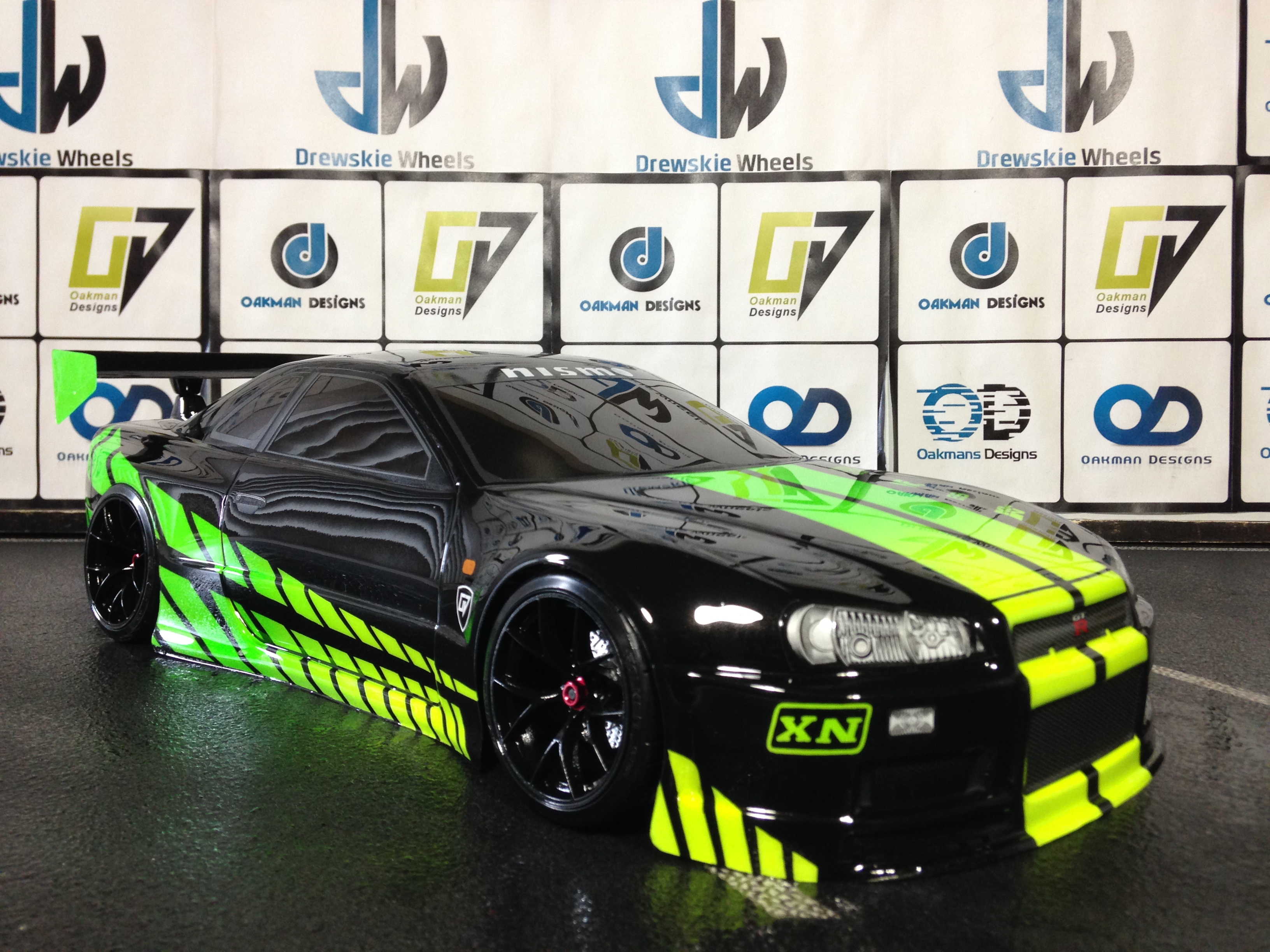
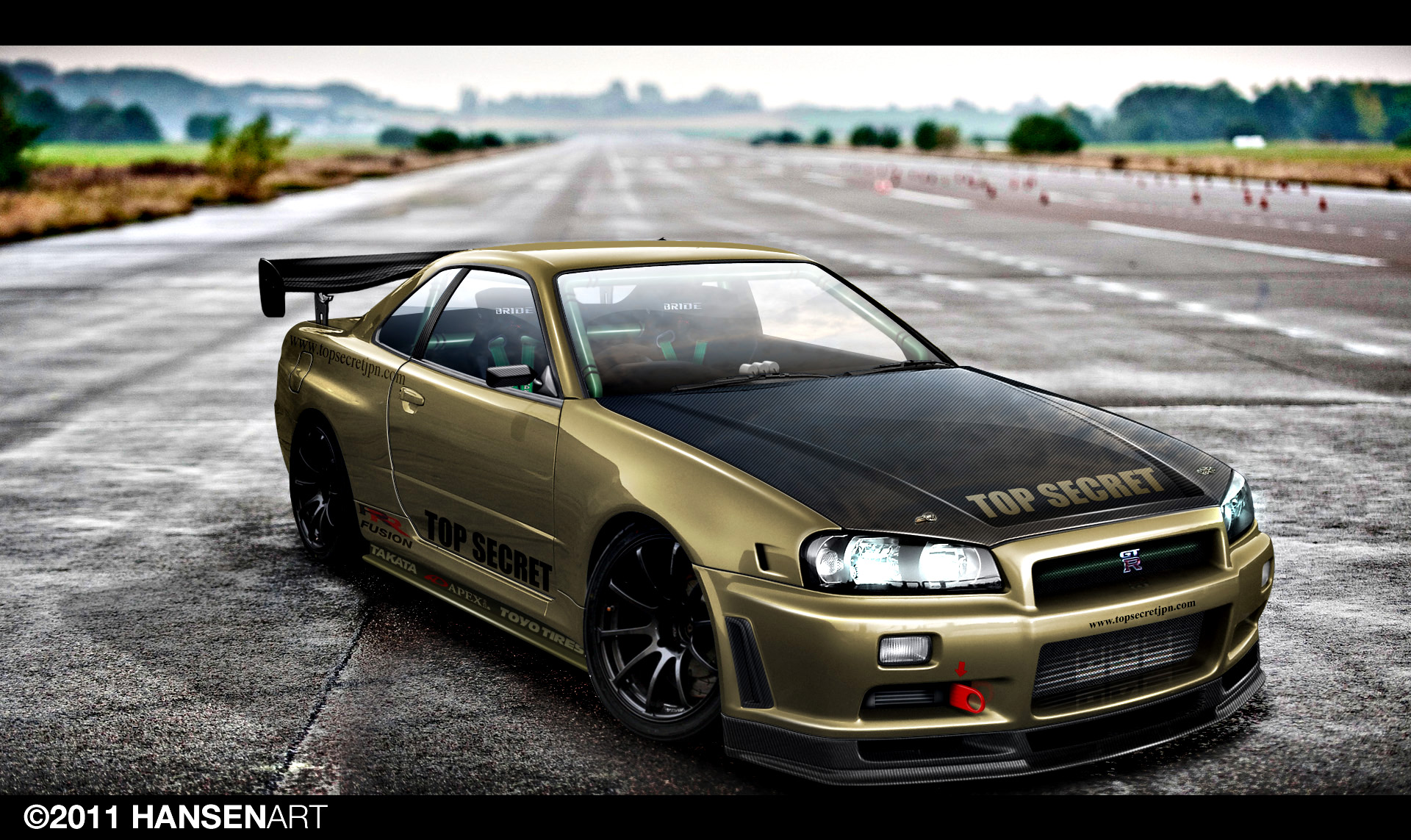




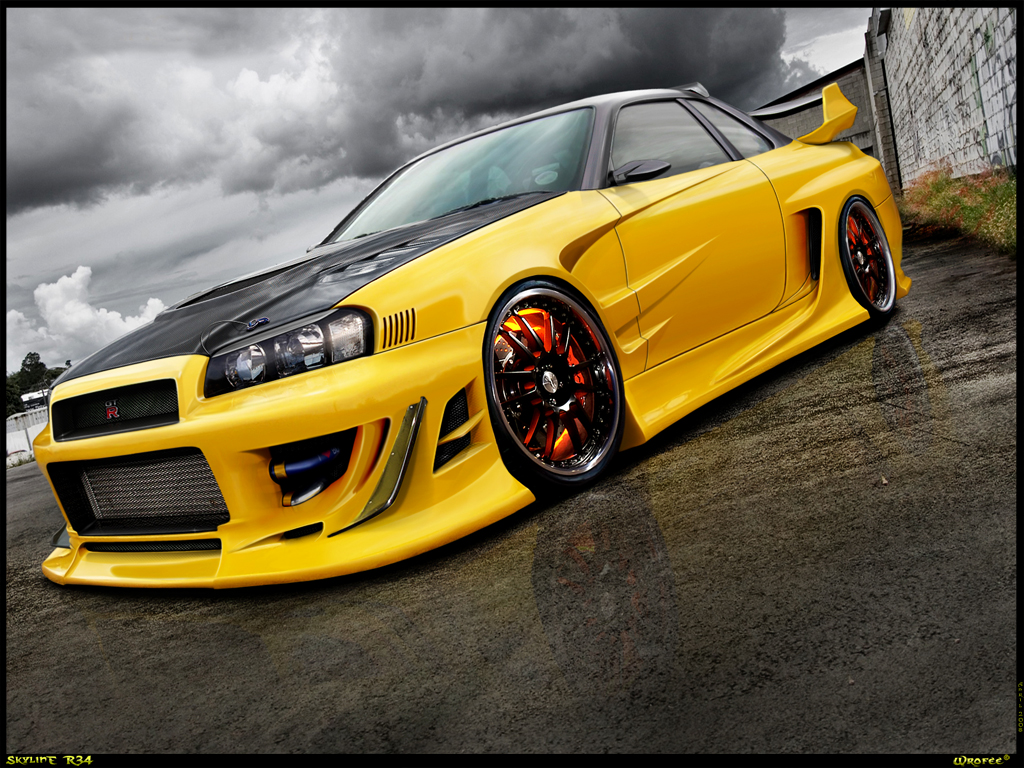


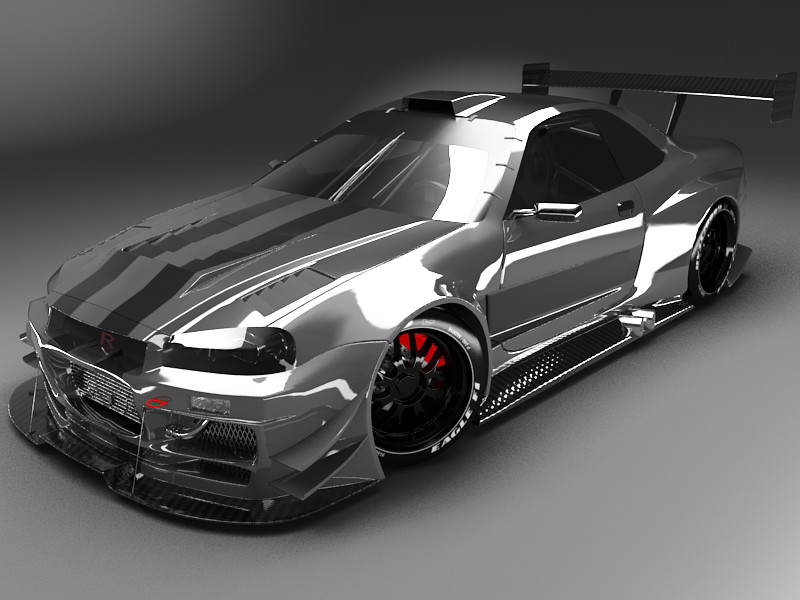


| Performance and efficiency | |
| 3.0-liter BMW TwinPower Turbo inline 6-cylinder, 24-valve 320-hp engine. Combines a twin-scroll turbocharger with variable valve control (Double-VANOS and Valvetronic) and high-precision direct injection | Electronic throttle control |
| Auto Start-Stop function | Air Curtains and Air Breather system |
| Electronically controlled engine cooling (map cooling) | Active kidney grille |
| Brake Energy Regeneration | Driving Dynamics Control with ECO PRO, ADAPTIVE, COMFORT, SPORT and SPORT+ modes |
| 8-speed Sport Automatic transmission with Sport and Manual shift modes, steering wheel-mounted paddle shifters and Launch Control | |
| Handling, ride and braking | |
| 4-wheel ventilated disc brakes with anti-lock braking system (ABS), composite front rotors and Dynamic Brake Control (DBC), brake-pad wear indicators and Cornering Brake Control (CBC) | Dynamic Stability Control (DSC), including Brake Fade Compensation, Start-off Assistant, Brake Drying, and Brake Stand-by features, with Dynamic Traction Control (DTC) |
| Dynamic Damper Control | Double-wishbone multi-link aluminum front suspension |
| Integral-V multi-link aluminum rear suspension | Aluminum front and rear subframes |
| Twin-tube gas-pressure shock absorbers | Carbon Core construction (includes carbon-fiber-reinforced plastic, aluminum, steel and magnesium body structure components) |
| Servotronic power-steering assist | Electronic limited-slip differential |
| 2-axle self-leveling air suspension | Electromechanical parking brake |
| Exterior | |
| V Spoke light alloy wheels (Style 642), 18 x 8.0; and 245/50 run-flat1 all-season tires2 | Adaptive LED Headlights |
| Automatic high beams | LED fog lights |
| Power-folding, heated side mirrors | Chrome accent finishes (front air intakes, rocker panel strips, rear trunk strip) |
| Non-metallic or Metallic paint | |
| Interior seating and trim | |
| 10-way power-adjustable driver's and front passenger's seat with 4-way lumbar support, and memory system for driver's seat, steering wheel and outside mirrors | Through-loading system |
| Dakota Leather upholstery | High-gloss Fineline Wood trim |
| Black panel center console with brushed aluminum controls and touch-sensitive controls | 3-stage heated front seats |
| Floormats | |
| Audio system | |
| Anti-theft AM/FM stereo CD/MP3 player with Radio Data System (RDS) | Harman Kardon® Surround Sound Audio System with equalizer and powerful 600-watt amplifier; the 16-speaker system includes 7 tweeters, 7 midrange speakers and 2 bass speakers |
| HD Radio™ with "multicast" FM station reception | SiriusXM® Satellite Radio with 1-year subscription |
| Instrumentation and controls | |
| 3-spoke leather-wrapped multi-function sport steering wheel with controls for audio system, cruise control, and Bluetooth® wireless communication for hands-free mobile phone3 | Enhanced USB and Bluetooth® including Mobile Office4 features; Message Dictation available with optional 3rd-party subscription |
| Black Panel Display with LCD main and trip odometer displays and warning indicators in dial faces | Rear-view Camera |
| iDrive 5.0 system with touch screen, touchpad Controller and 8 programmable memory buttons | BMW Navigation system with 10.2" high-resolution screen; 3-D maps; 200 GB hard drive with 20 GB storage for audio files; voice feedback and Voice command system |
| Gesture Control | 12.3" Dynamic Digital Instrument Cluster |
| Dynamic Cruise Control5 | Condition-Based Service display with additional functions accessible through iDrive system |
| Expanded Check Control vehicle monitor system | BMW Online with MyInfo and BMW Apps |
| BMW TeleService | Advanced Real Time Traffic Information |
| Tire Pressure Monitor | Rear-window defroster |
| Comfort and convenience | |
| Engine Start/Stop button | Advanced Vehicle & Key Memory includes climate-control temperature and air-distribution settings, exterior mirror and power seat settings, audio tone settings and radio presets, central-locking preferences, and lighting preferences |
| Comfort Access keyless entry with multi-function remote control and hands-free trunk-lid opening/closing | Power trunk-lid opening and closing |
| Soft-close automatic door operation | Automatic 4-zone climate control |
| Micro-filter ventilation system with replaceable active-charcoal filters | Automatic tilt-down of passenger's side-view mirror (when car is shifted into reverse gear) |
| Panoramic moonroof with fully automatic, 2-piece glass panel, power slide and lift control, wind deflector, and power interior sunshade | Power windows with key-off and "one touch" up and down operation both front and rear, anti-trapping feature, opening from remote, and closing from exterior lock |
| Automatic-dimming interior rear-view mirror and exterior side-view mirrors | Rain-sensing windshield wipers with adjustable speed and Automatic headlight control |
| Power tilt and telescopic steering wheel with automatic tilt-up for easy entry and exit | Park Distance Control, front and rear |
| Ground-illuminating lights in exterior door handles | LED light carpet |
| Interior courtesy lights with automatic-dimming function | Ambiance lighting |
| Front map lights and rear reading lights with separate controls for the left and right | Dual front sun visors with illuminated mirrors |
| Dual illuminated vanity mirrors integrated into rear cabin headliner | Dual cupholders in front and rear |
| Fold-up rear-seat center armrest | Open storage compartments in all doors and front-seatback storage |
| Fully finished trunk with interior and remote trunk release | Locking glovebox |
| Universal garage-door opener | Power outlets in front passenger's footwell, back of center console, and in trunk |
| WiFi Hotspot including 3 GB and 3-month trial | Wireless charging (Qi charging standard) |
| 2x USB ports with 2.1A charging | Concierge Services with Critical Calling |
| BMW Ultimate Benefits™ for 7 Series | |
| Safety and security | |
| Adaptive Brakelights | BMW's Active Protection System detects imminent accidents, then prepares by automatically pretensioning safety belts, closing windows and moonroof, and activating post-crash braking; includes Attention Assistant feature |
| Carbon Core construction in passenger cell area | Front- and rear-seat Head Protection System (HPS) |
| Active Front Headrests | Driver's and passenger's front airbag supplemental restraint system (SRS) with advanced technology: dual-threshold, dual-stage deployment; and front-passenger-seat sensors designed to prevent unnecessary airbag deployment |
| 3-point safety belts with force limiters and head restraints at all seating positions | Seat-mounted front side-impact airbags |
| Acoustic safety-belt warning | Front safety belts with automatic pretensioners |
| Interlocking door anchoring system to help protect against door intrusion in side impacts | LATCH attachments for child-restraint safety installation |
| Automatic-locking retractors (ALR) on all passenger-seat safety belts (for installation of child-restraint seats) | Impact sensor that activates Battery Safety Terminal disconnect of alternator, fuel pump and starter from battery; automatically unlocks doors, and turns on hazard and interior lights |
| Anti-theft alarm system | Programmable LED Daytime Running Lights |
| Coded Driveaway Protection (prevents engine start when your key fob with constantly changing electronic code is not used) | Pathway Lighting feature, programmable via Vehicle & Key Memory |
| BMW Assist eCall™ includes Emergency Request (SOS button) and Enhanced Automatic Collision Notification | BMW Remote Services includes Stolen Vehicle Recovery, Remote Door Unlock and My BMW Remote app |
| HV37/HNV37/ZV37 | ||||||||||||||||||||||||||||||||||||||
|---|---|---|---|---|---|---|---|---|---|---|---|---|---|---|---|---|---|---|---|---|---|---|---|---|---|---|---|---|---|---|---|---|---|---|---|---|---|---|
 |
||||||||||||||||||||||||||||||||||||||
| Overview | ||||||||||||||||||||||||||||||||||||||
| Also called | Skyline Skyline Hybrid Infiniti Q50 |
|||||||||||||||||||||||||||||||||||||
| Production | 2014–Present | |||||||||||||||||||||||||||||||||||||
| Assembly | Tochigi, Tochigi, Japan | |||||||||||||||||||||||||||||||||||||
| Designer | Joel Baek (2011) | |||||||||||||||||||||||||||||||||||||
| Body and chassis | ||||||||||||||||||||||||||||||||||||||
| Body style | 4-door sedan | |||||||||||||||||||||||||||||||||||||
| Layout | Front engine, rear-wheel drive / four-wheel drive | |||||||||||||||||||||||||||||||||||||
| Platform | Nissan FM platform | |||||||||||||||||||||||||||||||||||||
| Powertrain | ||||||||||||||||||||||||||||||||||||||
| Engine | 3.5 L VQ35HR V6 with HM34 electric motor | |||||||||||||||||||||||||||||||||||||
| Transmission | 7-speed automatic | |||||||||||||||||||||||||||||||||||||
| Dimensions | ||||||||||||||||||||||||||||||||||||||
| Wheelbase | 2,850 millimetres (112 in) | |||||||||||||||||||||||||||||||||||||
| Length | 4,790 millimetres (189 in) | |||||||||||||||||||||||||||||||||||||
| Width | 1,820 millimetres (72 in) | |||||||||||||||||||||||||||||||||||||
| Height | 1,440 millimetres (57 in) - 1,450 millimetres (57 in) | |||||||||||||||||||||||||||||||||||||
| Chassis code | V36 | CV36 |
|---|---|---|
| Body style | sedan | coupe |
| 250GT | 2006– | n/a |
| 250GT FOUR | 2006– | n/a |
| 350GT | 2006–2008 | n/a |
| 370GT | n/a | 2007– |
| Model | Years | Engine Type/code | Power, torque@rpm | Drive |
|---|---|---|---|---|
| 250GT sedan (DBA-V36) | 2006– | 2,495 cc (2.495 L; 152.3 cu in) V6 (VQ25HR) | 225 PS (165 kW; 222 hp)@6800, 263 N·m (194 lb·ft)@4800 | RWD |
| 250GT FOUR sedan (DBA-NV36) | 2006– | 2,495 cc (2.495 L; 152.3 cu in) V6 (VQ25HR) | 225 PS (165 kW; 222 hp)@6800, 263 N·m (194 lb·ft)@4800 | AWD |
| 350GT sedan | 2006–2008 | 3,498 cc (3.498 L; 213.5 cu in) V6 (VQ35HR) | 315 PS (232 kW; 311 hp)@6800, 358 N·m (264 lb·ft)@4800 | RWD |
| 370GT coupe (DBA-CKV36) | 2007– | 3,696 cc (3.696 L; 225.5 cu in) V6 (VQ37VHR) | 333 PS (245 kW; 328 hp)@7000, 363 N·m (268 lb·ft)@5200 | RWD |
| Model | Years | Standard | Optional |
|---|---|---|---|
| 250GT sedan | 2006– | 5-speed automatic | — |
| 250GT FOUR sedan | 2006– | 5-speed automatic | — |
| 350GT sedan | 2006–2008 | 5-speed automatic | — |
| 370GT coupe | 2007–2008 | 5-speed automatic | 6-speed manual (Type S, Type SP) |
| V36, CV36, J50 | |
|---|---|
 |
|
| Overview | |
| Also called |
Infiniti G352007-2008 Infiniti G37 2009-2014 Infinti Q40. 2014- Infinti Q60 coupe |
| Production | 2006–2014 |
| Assembly | Tochigi, Tochigi, Japan |
| Designer | Hideo Komuro (2004); Shinichiro Irie (2005, 2007) |
| Body and chassis | |
| Body style | 4-door sedan 2-door coupe 5-door crossover SUV |
| Layout | Front engine, rear-wheel drive / all-wheel drive |
| Platform | Nissan FM platform |
| Related | Infiniti FX Infiniti M Nissan 350Z Infiniti G37 Infiniti EX Nissan 370Z |
| Powertrain | |
| Engine | |
| Transmission | 5-speed automatic 6-speed manual 7-speed automatic |
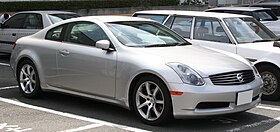 |
|
| Overview | |
|---|---|
| Also called | New Generation Skyline Infiniti G35 |
| Production | sedan: 2001–2006 coupe: 2002–2007 |
| Assembly | Tochigi, Tochigi, Japan |
| Designer | Hiroshi Hasegawa (1998, 2000) |
| Body and chassis | |
| Body style | 4-door sedan 2-door coupe |
| Layout | Front engine, rear-wheel drive / four-wheel drive |
| Platform | Nissan FM platform |
| Powertrain | |
| Engine | 2.5 L VQ25DD V6 3.0 L VQ30DD V6 3.5 L VQ35DE V6 |
| Transmission | 5-speed automatic 6-speed manual CVT Continuously Variable Transmission |
| Dimensions | |
| Wheelbase | 2850 mm (112.2 in) |
| Length | 4630 mm (182.2 in) (coupe) 4735 mm (186.5 in) (sedan) |
| Width | 1815 mm (71.5 in) (coupe) 1750 mm (69 in) (sedan) |
| Height | 1390 mm (54.8 in) (coupe) 1465 mm (57.7 in) (sedan) |
| Curb weight | 3,373 lb (1,530 kg) (coupe 6MT)[42] 3,395 lb (1,540 kg) (coupe 5AT)[42] 3,395 lb (1,540 kg) (sedan 6MT) 3,351 lb (1,520 kg) (sedan 5AT)[43] 3,483 lb (1,580 kg) (sedan CVT-8) |
| R34 | |
|---|---|
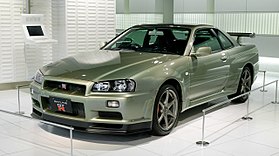 |
|
| Overview | |
| Production | 1999–2002 64,623 units sold |
| Assembly | Musashimurayama, Japan |
| Designer | Kozo Watanabe (1996) |
| Body and chassis | |
| Body style | 4-door sedan 2-door coupe |
| Layout | Front engine, rear-wheel drive / four-wheel drive |
| Related | Nissan Laurel Nissan Stagea Nissan Skyline GT-R |
| Powertrain | |
| Engine | 2.0 L RB20DE I6 (GT) 2.5 L RB25DE I6 (25 GT, GT-X, GT-V, GT-4) 2.5 L RB25DET Turbocharged I6 (GT-T) 2.6 L Twin Turbocharged RB26DETT I6 (GT-R) |
| Transmission | 4-speed automatic 5-speed manual 6-speed manual |
| R33 | |
|---|---|
 |
|
| Overview | |
| Production | 1993–1998 217,133 units sold |
| Assembly | Musashimurayama, Japan |
| Designer | Kozo Watanabe (1991) |
| Body and chassis | |
| Body style | 4-door sedan 2-door coupe |
| Layout | Front engine, rear-wheel drive / four-wheel drive |
| Related | Nissan Laurel Nissan Stagea |
| Powertrain | |
| Engine | 2.0 L RB20E I6 (GTS) 2.5 L RB25DE I6 (GTS-25, GTS-4) 2.5 L RB25DET I6 (GTS-25t, GTS-R) 2.6 L RB26DETT I6 (GT-R) 2.8 L RBX-GT2 I6 (400R) |
| Transmission | 4-speed automatic 5-speed manual 5-speed automatic |
| Dimensions | |
| Wheelbase | 2,720 mm (107.1 in) |
| Length | 4,720 mm (185.8 in) (sedan) |
| Width | 1,720 mm (67.7 in) |
| Height | 1,360 mm (53.5 in) (sedan) |
| Curb weight | 1,390 kg (3,064.4 lb) (GTS-25t) 1,530 kg (3,373.1 lb) (GT-R) |